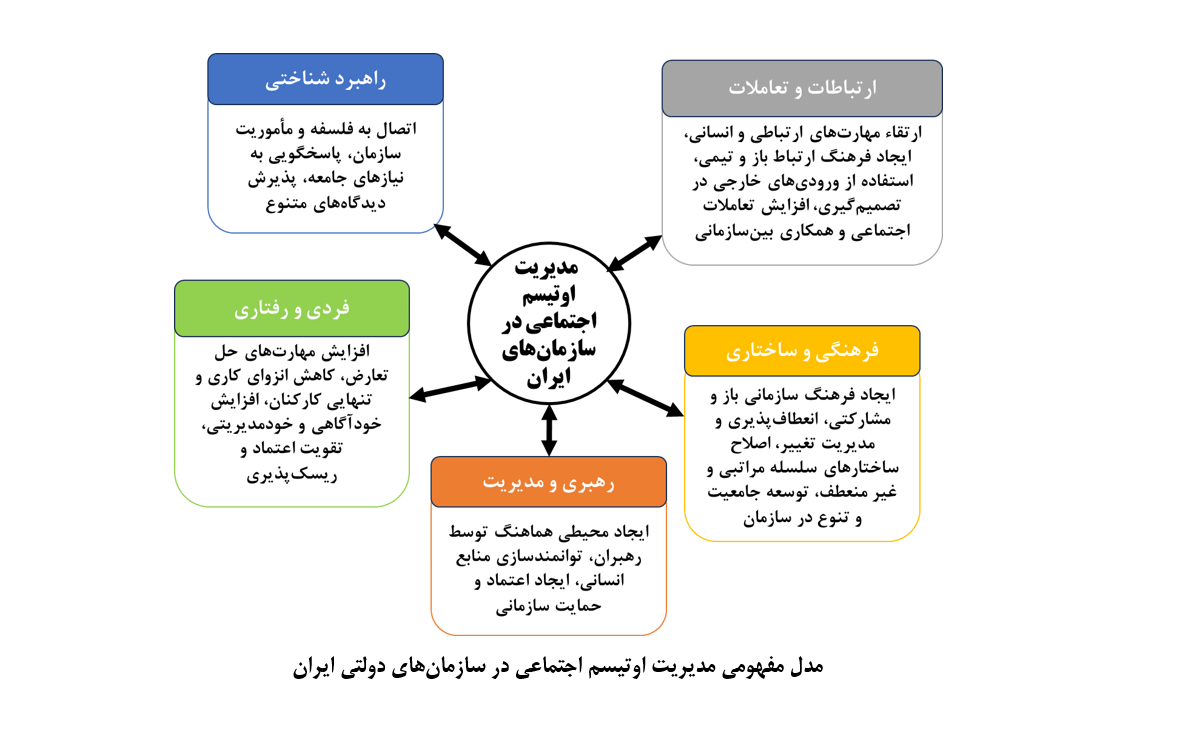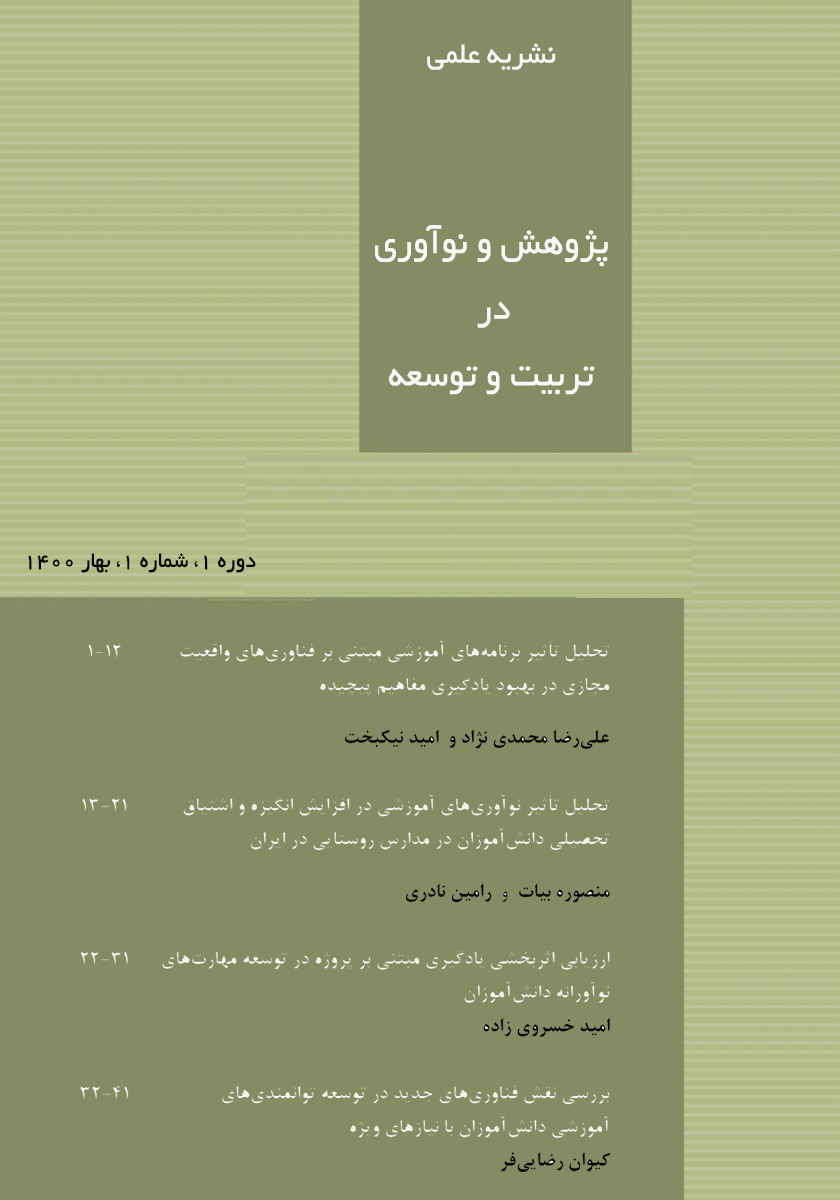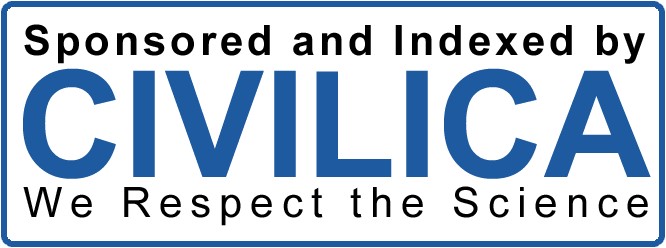A Conceptual Model of Social Autism Management in Iranian Governmental Organizations: A Thematic Analysis Approach
Keywords:
Social autism, government organizations, Management, conceptual model, Content analysisAbstract
The aim of this study is to present a conceptual model for managing social autism within Iranian governmental organizations, utilizing a qualitative research methodology based on thematic analysis. The research population consisted of academic experts, executive specialists in governmental organizations, organizational psychologists, autism researchers, and other relevant stakeholders in the field of social autism management in public sector workplaces. Sampling was conducted using a combination of purposive (judgmental) and snowball techniques, and thematic saturation was achieved after 17 semi-structured interviews. Data were collected through in-depth semi-structured interviews and analyzed using the six-phase thematic analysis method proposed by Braun and Clarke (2006). To ensure the validity of the study, the criteria of credibility, transferability, confirmability, and dependability were evaluated and confirmed. The inter-coder agreement rate was reported at 81%, indicating high reliability of the analysis. Thematic analysis results yielded 151 semantic statements, which were categorized into 62 open codes, subsequently grouped into 18 axial codes and ultimately synthesized into 5 main dimensions. These five dimensions include: "Strategic and Cognitive," "Communication and Interactions," "Cultural and Structural," "Leadership and Management," and "Individual and Behavioral." By providing an integrated and operational conceptual model, this study addresses contemporary challenges of social autism in governmental organizations and can serve as a guide for policymaking and the promotion of inclusive workplace environments. The novelty of this research lies in its presentation of the first localized conceptual model for managing social autism within Iranian governmental organizations.
Downloads
References
Parsons BM, Pinzone M, Albè F, Orlandelli D, Barletta I, Berlin C, et al. Local autism policy networks: Expertise and intermediary organizations A framework for operative and social sustainability functionalities in Human-Centric Cyber-Physical Production Systems. Educational Policy. 2018;32(6):823-54. doi: 10.1177/0895904816673743 10.1016/j.cie.2018.03.028.
Kester JS, Hill T, Thompson L, Black CL, Coriano VL, Bruton J, et al. Variance in Autism Prevalence: Links with State-Level Autism Resources. Journal of Disability Policy Studies. 2023:10442073231156940. doi: 10.1177/10442073231156940.
Georgeac OA, Rattan A. The business case for diversity backfires: Detrimental effects of organizations' instrumental diversity rhetoric for underrepresented group members' sense of belonging. Journal of Personality and Social Psychology. 2023;124(1):69. doi: 10.1037/pspi0000394.
Sajjad A, Shahbaz W. Mindfulness and social sustainability: An integrative review. Social Indicators Research. 2020;150(1):73-94. doi: 10.1007/s11205-020-02297-9.
Farzaneh A, Seddigh Orouei G, Bagheri M. Empirical Typology of Social Interaction Problems in the Neighborhood Relationship Network (Research Case: Mashhad City). Journal of Iranian Social Studies. 2023;17(3):153-85.
Deutschmann JW, Lipscomb M, Schechter L, Zhu J. Spillovers without social interactions in urban sanitation. American Economic Journal: Applied Economics. 2024;16(3):482-515. doi: 10.1257/app.20220047.
Chuang S. Indispensable skills for human employees in the age of robots and AI. European Journal of Training and Development. 2022. doi: 10.1108/EJTD-06-2022-0062.
Shamsi S, Pourateshi M, Zamani A. Investigating the Relationship Between Managers' Communication Skills and Leadership Style with Human Resource Empowerment: A Case Study of Dr. Shariati Technical College. Karafan Scientific Quarterly. 2019;16(2):141-60.
Kaplan LR, Farooque M, Sarewitz D, Tomblin D. Designing participatory technology assessments: a reflexive method for advancing the public role in science policy decision-making. Technological Forecasting and Social Change. 2021;171:120974. doi: 10.1016/j.techfore.2021.120974.
Waldman DA, Sparr JL. Rethinking diversity strategies: An application of paradox and positive organization behavior theories. Academy of Management Perspectives. 2023;37(2):174EP - 92. doi: 10.5465/amp.2021.0183.
Rasool SF, Wang M, Tang M, Saeed A, Iqbal J. What a toxic workplace environment effects the employee engagement: The mediating role of organizational support and employee wellbeing. International journal of environmental research and public health. 2021;18(5):2294. doi: 10.3390/ijerph18052294.
Goldhaber GM. Organizational communication1993.
Sumaiya B, Srivastava S, Jain V, Prakash V. The Role of Effective Communication Skills in Professional Life. World Journal of English Language. 2022;12(3):134-40. doi: 10.5430/wjel.v12n3p134.
John-Eke EC, Akintokunbo OO. Conflict management as a tool for increasing organizational effectiveness: A review of literature. International Journal of Academic Research in Business and Social Sciences. 2020;10(5):299-311. doi: 10.6007/IJARBSS/v10-i5/7198ER -.
Boikanyo DH, Naidoo M. The influence of organisational support, advancement, meaningfulness and psychological safety on employee engagement in a petrochemical organisation. WSEAS TRANSACTIONS ON BUSINESS AND ECONOMICS. 2023;20:1100-9. doi: 10.37394/23207.2023.20.98.
Shore LM, Cleveland JN, Sanchez D. Inclusive workplaces: A review and model. Human Resource Management Review. 2018;28(2):176-89. doi: 10.1016/j.hrmr.2017.07.003.
Nishii LH. The benefits of climate for inclusion for gender-diverse groups. Academy of Management journal. 2013;56(6):1754-74. doi: 10.5465/amj.2009.0823.
Georgakopoulos A, Allen B, Petzold-Bradley E. Managing Organizational Conflicts Through Innovation, Creativity, and Inclusion: Implementing a Conflict System of Shared Leadership. De Gruyter Handbook of Organizational Conflict Management2022. p. 233.
Da Rocha JPP, Frazier EB. Conflict, Systems, and Approaches to Conflict Management: An Overview. Strategic Approaches for Conflict Resolution in Organizations: Emerging Research and Opportunities2020. p. 1-30.
Nguyen TD. Resolving conflict in organizations-achieving results through a harmonization process. Development and Learning in Organizations: An International Journal. 2019;33(5):4-7. doi: 10.1108/DLO-10-2018-0136.
Vandergoot S, Sarris A, Kirby N. Factors That Influence the Training Transfer and Maintenance of Conflict Resolution Programs of Healthcare Training and Development Units: A Retrospective Study. Applied Psychology Readings: Selected Papers from Singapore Conference on Applied Psychology, 20172018. p. 103-21.
Hartmann CW, Engle RL, Pimentel CB, Mills WL, Clark VA, Keleher VC. Virtual external implementation facilitation: Successful methods for remotely engaging groups in quality improvement. Implementation science communications. 2021;2(1):1-10. doi: 10.1186/s43058-021-00168-z.
Cwinn E, Barry EA, Weisz JR, Bailin A, Fitzpatrick OM, Venturo-Conerly K, et al. Brief digital interventions: An implementation-sensitive approach to addressing school mental health needs of youth with mild and emerging mental health difficulties. Canadian Journal of Community Mental Health. 2022;41(3):157-75. doi: 10.7870/cjcmh-2022-026.
Kotter JP. Leading change: Harvard business press; 2012.
Northouse PG. Leadership: Theory and practice: Sage publications; 2021.

Downloads
Published
Submitted
Revised
Accepted
Issue
Section
License
Copyright (c) 2025 Naghmeh Keyhanian (Author); Mehran Mokhtari Bayekolaei (Corresponding author); Davood Kia Kojouri (Author)

This work is licensed under a Creative Commons Attribution-NonCommercial 4.0 International License.










